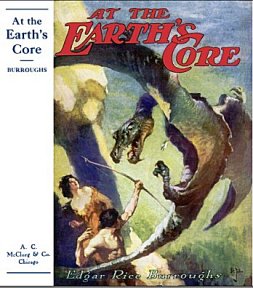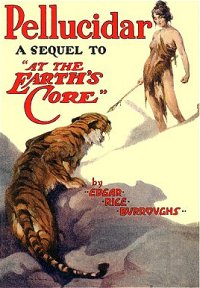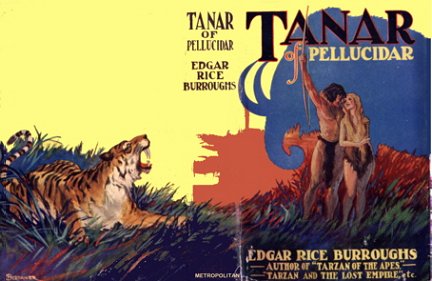By keeping analyzing ERB's Opus, I came to develop
the desire to go really deep in my investigation. So deep, to the point
of reaching Pellucidar…
This buried world is among the most peculiar in the ERB
universe. Of course, other analysts like our good old Den
Valdron have had their say on it, and a strong say at that. Still,
there remain some things, here and there, that could be added to the texts
already written.
So I will attack and … unearth the various aspects that
interest me about Pellucidar as follows; I hope you'll …dig it:
The problem
of the climate
To begin with, as big and mighty as it appears to be,
the famous inner sun seems weak, for a handful of reasons:
First, the reader learns on many occasions along the opus
that it is enough to have some dense shadow, even induced by clouds or
dense foliage, to provoke cool temperatures. The eternal noon seems heavy
enough to necessitate shelter from its light, at least from time to time,
but nevertheless, it seems to get a bit too frisky in the dense forests
like the Forest of Death, or during the rains. On the other hand, some
adventures take place in caves, which are dark by definition, and it's
nowhere mentioned that it's cold inside them. Now that's curious and I
think it gives us a clue on something: within Pellucidar, the heat at ground
level comes in equal measure from the inner orb and from the ground itself.
Since we have to do with an inner world, we can suppose its tectonical
plates are thinner than ours and so, the heat from the magma beneath comes
a bit more to the surface than it does upon our side of the planet. Also,
the heat accumulates instead of dissipating into space as it happens in
our case. All these difference point to the case of a weak sun, that gives
apparently lots of light and heat, but in fact, this plentiness is more
due to their cumulative effect than to their strength. In the depths of
the earth like the caves, you have more magma-originated heat accumulated,
so you don't feel cold. But right at the surface, the effect of this ground
heat is much more dissipated and the heat from the sun is feeble, as a
bit of shadow suffices to show.
Another clue is the existence of different races of humans
and humanoids, even if the living conditions and the light intensity and
all seem to be the same everywhere – that means there’s no significant
influence of the sun upon the metabolism and the tendency of nature to
adaptation-mutation; we have to link this clue with all these living fossils
roaming around. We have thus the evidence the ecosystem of Pellucidar is
more of a conservative rather than an innovative one – and that means it
runs at low levels of energy, as it is known that life is boosted by mutations
and climate changes induced mostly by the variations of the input of solar
energy.
What about the water cycle? Well, it seems there’s no
much rain upon/in Pellucidar – in the books we witness only two in fact,
during Tarzan's foray into Zoram and after David escapes the tribe of crazy
people, if I remember well. In fact we clearly notice the scarcity of storms
upon land and their relative frequency upon sea (there’s at least one almost
each time a character takes the sea) – but what can be the cause of this
difference? I'd risk the hypothesis that giving the eternal day and uniform
climate and temperatures, the water cycle in Pellucidar is very local in
the sense that what evaporates, precipitates fairy rapidly back on the
soil. The land doesn't hold much moisture so, what evaporates must mostly
come back as dew, rapidly sucked by the ground and the plants and therefore
mostly invisible at a casual glance. But upon the sea, the matter is different,
there’s plenty of water and the strong rhythm of evaporation under the
eternal day must lead to a lot of accumulation of clouds and with them
energy, electricity, you name them.
Could there be any significant variation of the climatic
condition in Pellucidar? Yes there is variation, the vegetation is different
- there are forests, savannas, swamps etc. there has to be variation, but
less because of the climate or the water cycle as we saw they are very
uniform, as the differences are more likely to be in function of the position
of the chains of mountains and the water expanses towards each other,
and also probably the degree of remoteness from the sea and the position
of the region in respect to the humid atmospheric currents that may exist.
Another cause of the difference of vegetation could be the composition
of the soils, as it is known that plants don't thrive uniformly on any
soil.
Desserts could be possible – though unlikely since some
amount of moisture must be present and therefore recycle locally in any
region. So the dry areas must be more like savannas, or like “green deserts”
as is Australia.
What influence do the Polar openings have upon the climate?
ERB says the winds of the inner world are influenced by the exterior polar
summer and winter, but since the polar openings don't seem to be very large,
their influence must be rather small at the scale of the whole world, I
don't think they beat the heat of the eternal sun at any moment, except
in their own vicinity.
The mahars
The problem of this non-human dominant species is one
of the most interesting of the cycle.
They are obviously universally known, since most tribes
talk of them as we see in the books – even the tribe of Ja-ru which is
thousands of miles away from the Peninsula where most of the action happens.
Yet, we never see them out of their domain which seems to be confined to
the eastern part of the Peninsula, more precisely the territory between
the eastern ocean and the Terrible Mountains which run along the spine
of the named peninsula. They don't seem to have cities north of Kali and
Suvi, nor westwards of the named mountains, nor south of the Straits where
the bronze-age towns are found…
How can they be so much known and yet so absent? How come
they and the Korsars never met until the 1930s? Even in the rather complicated
theology of the bronze-age Xexot people, there’s no place for them…
They had a world map of Pellucidar in Phutra, as shown
in the first book. They had obviously surveyed all their world and knew
it was spherical. Yet they didn't discover the polar openings and the exterior
world of ours. Which could be a proof of two things: one, these openings
are definitely small and easily missed during a not very systematic exploration.
And second, their mapping skills can't be much more evolved than say, our
medieval ones.
I would try a very likely hypothesis, that of an ancient
presence pretty much everywhere, followed by a very steep numerical decline.
All this, long before the arrival of David and Perry and even that of
the Korsars.
But what would make this mighty race dwindle to only a
fraction of the planet territory? I mean, the Peninsula seems bigger than
half Europe or so, but it's only a bit of the total land mass of Pellucidar.
Why did this happen, since there’s no mention of any catastrophe occurring
in the past, that could explain their retreat?
Well, what if this dwindling was a chosen one? After all,
the Mahars don't reproduce naturally since a long time… Maybe they chose
to retreat to their heartland and renounce the rest of the world, while
keeping a minimal number of themselves living. It seems like a very unlikely
political choice, but we do see upon our side of the planet the same thing
happening under our eyes: didn't the West, after all, retreat from many
of its colonies even if there was no serious resistance in them? It did
it just because the post-1945 generations were not willing to fight anymore,
and because capitalism had discovered better ways to use the human capital
than the direct domination. For not to speak of the fall in birthrate of
all the developed and prosperous countries. Of course, corporate capitalism
doesn't apply to the Mahars, and sure as “Molop Az”, our vision of hedonism
doesn't either; but they could have had a similar drive.
Let's talk a bit about the Mahar religion, which I think
is much more interesting than it would seem.
Basically, they secretly gather in subterranean temples
where they bring humans, hypnotize them, make them swim and eat them alive
bit by bit. Charming, but what could be the significance of all this? And
what is all about their secrecy about eating warm blooded creatures? Why
such secrecy when you're dominant and you don't even believe the dominated
ones even understand basic stuff? And why they leave the men to the thipdars?
For starters, they don't seem to believe in some personal
supernatural instance. They are said to believe that “everything has been
made for them”. By someone? Not necessarily. Both Buddhists and Daoists
believe that the world is whether an illusion or a whirlwind of materialized
energies in different mixing of Yin and Yang. If gods there are they are
subjected to the big scheme of things like everybody else. So the Mahars
are likely to think that they are the embodiment of reason and perfection
that the energies composing the world strive to achieve as a part of some
cosmic destiny – well, rather pocket-dimension-destiny, in this case. Think
of the Omega Point of de Chardin or Steiner, or something like that. So
basically, the Mahars celebrate their own magnificence as Elected of the
Nature, by playing with, and gulping, their subjects. Now, why should their
sacred meal not be warm blooded – has this anything to do with some sort
of Mana transfer? The natives from many of our tribes believe that since
each being has a part of sacred energy in him, eating him according to
certain rituals gives this energy, the Mana as commonly known, to the eater
as a supplement of force and sacrality. But here's the problem, to extract
mana means the victim is worthy… Maybe that's why the Mahars don't want
the world to know they eat warm-blooded “gilaks”.
Why would the Mahars consider humans worthy?
Not necessarily because they would have any hint of their
intelligence. Maybe they have appraised humans as resourceful beasts, as
we appreciate the Dinosaurs, or something. But maybe they fear their potential,
although they don't admit it.
Why would they eat them outside their cities, since they
consider these as holly places? I mean, nothing's best than dispatching
the enemy within the perimeter of the holly place… Instead of what, they
seem to reserve the cities for the arena games, where the victims do have
a chance to escape. Maybe they believe in Fate and since fate doesn't play
in their temples, they feel like forcing it. Maybe that's why this side
of their rituals takes place on Mezop, meaning enemy, ground. Cities reserved
for rituals where Fate reigns, whereas the temples in the enemy islands
are reserved to the cult of Mahar Strength. Makes sense.
Why the prohibition of the warm blood? Maybe it is commonly
believed that only reptiles have the right Mana, and the collection of
it from warm blooded creatures would be a weakness, like a doubting of
the reptilian superiority. I begin to suspect the Mahars were aware of
the human potential for supremacy, if not of the human intelligence…
Why eating only the women and children and leave the men
to the pterodactyls? Well, maybe they are fascinated with live birth? Maybe
they consider the essence of the sacred force passes through the females,
as they believe about themselves by the way? Also, maybe they fear humans
secretly and want to debase them by depreciating the strongest ones, deeming
them as just food for the lesser subjects.
These are my suggestions. We don't have many details to
develop too much. But maybe later, after some more inspiration…
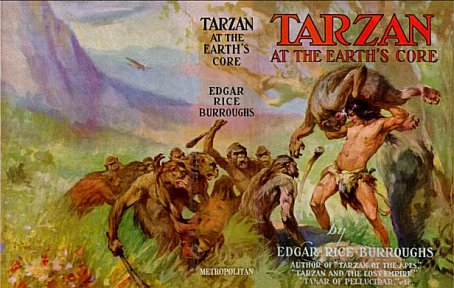
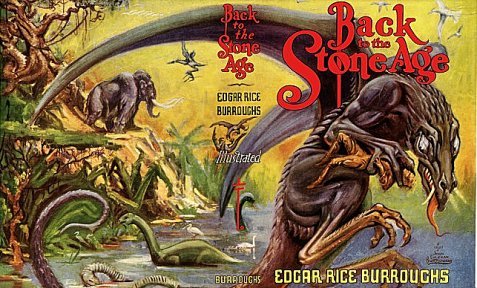
Demography,
my old love…
Let's see what we can say about the state of the population
in Pellucidar. What appear to be its characteristics: well the most striking
seem to be the long life and the low birthrate. We see in the books that
people don't age very quickly – Perry actually gets better! Anyway, I think
the old sailor that appears in the last book is a quite good indicator
of what goes on there: he was 40 when he arrived in the inner world, and
he was feeling 60 when he appeared in the book. While in fact he was 150
something! Which means that people do get old, but at a pace 4-5 times
slower than upon the surface! Which means that in order to get to look
70, one there should live 280-350 of our years. The counterpart of a 120
old would be 600 in Pellucidar!
Why would people live for so long? Well, might be, among
other things, the significantly smaller amount of radiation from the Sun
and from outer space. As I said, Pellucidar is a conservative environment,
there are no adaptive/evolutive mutations there, but the small amount of
change probably also means a smaller entropy…
What about the low birthrate? Well, no wonder it's low
with such long lives. But what exactly is the situation? Well, we encounter
a lot of families with just one kid, in all the books. Two seem to be the
norm. As a matter of fact, only one family from Zoram and one from Hime
appear with 3 kids. Just read the books. Many families have just one son/daughter,
and when some boast 7 brothers nobody believes them, although that should
rather be the norm, from what we know of ancient demography in tribal times…
Would such a small birthrate be sustainable, with all
these man-eating monsters loitering around, and all these charming human
relations the guys there seem to have the secret? Well, let's review a
bit the approximative reasons for mortality, and the violence:
intra-tribal violence: normally it should be low, small groups
can't afford strong inner tensions due to conflicts between their members;
as a rule, all observable tribes in our world punish severely such tensions,
as a matter of fact they punish severely even things we regard lightly;
the tribes down below should be no exception
inter-tribal violence: this too should be rare, for the tribes
appear to be very scattered, with hundreds of miles of empty terrain between
them; as a matter of fact, the stealing of girls seems to be the only source
of armed conflict in 90% of the cases, throughout the books; also, we notice
that even in case of total victory, the victor seldom exterminates the
vanquished, as we see with the two rival tribes on the floating islands
the Mahars seem to activate only in the Eastern parts of
the Peninsula
most captives appear to be made slaves rather than killed/eaten
the beasts: that's another story; but, let's analyze the
odds one primordial human denizen has to be masticated by some Megafauna
club member. It appears the tribes don't move a lot around, unlike the
ones that once roamed the surface of our orb. As you might know, our own
ancestors were moving a lot in search for food, since they were following
the pattern of seasonal change, and the resulting migration of the animals
they were consuming. These displacements were implying a constant modification
of their routines, and were very likely to produce accidents and stuff.
On the other hand, in Pellucidar there are no seasons so, likely no significant
migrations of the herds. Maybe just local ones, in the sense that for example
the Triceratopses move a bit further in the Gyor Kors after depleting the
grass from a certain surface. Therefore, humans are very likely to just
stay put, in the best place of the territory, from where most of the herds
are easily reachable. Maybe at a distance as equal as possible from the
most unavoidable passes and fords and drinking places and other spots where
one can be sure to find prey often and where the said prey doesn't have
much space to move. The humans must be really good at the routine established
in each of the hunting places, since these don't vary much. And since they
are good, they are likely to avoid many accidents and injuries that would
occur in more unstable scenarios. Also, we are repeatedly told in the books
that when humans are in large groups – more than three appears to be ok
already – animals usually don't attack unless they are the biggest bosses
in the Megafauna club. All this can only mean that losses by animal attack
can't be that many, anyway not as many as one would expect. As a matter
of fact, we see that it's usually some mistake, some rush or some strong
incentive that brings a lone hero/heroine to try his/her chances alone
in the wild. Usually humans go grouped, and then relatively few things
can happen to them. Which brings us to consider that for most people, who
don't run away alone, the wild beasts can't be too much of a reason for
high mortality either.
One thing appears to be peculiar for the tribes of Pellucidar,
and that's their effectives. From what we see, most tribes appear to comprise
between 300 and 500 people, or so. That's bigger than the average Terrestrial
ones of the Paleolithic, which are not bigger than 40 to 200 at most. Must
be the particular conditions linked to the lack of seasonality I talked
about above. I mean, a more luxuriant and stable nature means a lot more
animals, and these mean more food. Especially if they don't migrate a lot.
Speaking of demography, one can't help noticing the difference
between the Peninsula upon which the Empire develops, versus the rest of
the world: indeed, the tribes seem to be much bigger and more frequent
there than in other regions of the inner world: I mean, in all the adventures
that take place somewhere else, except among the Korsars, one notices how
far away are the tribes one from the others and how they aren't more than
500 strong. Whereas in the Peninsula, we know there are at least 20 tribes,
and that they can muster tens of thousands of warriors! That's 500 to 1,000
armed males per tribe, which means the tribes are on average much bigger
than 1,000. Also, we learn that most are composed of more than one village.
To give a global image of the situation, it looks like
outside the Peninsula, there is no more than a 200-500 strong tribe every
10,000 sq mi (20-30,000 sq km), or so. Which gives a density of 2-3 people
per 100 square kilometers (5-6 per 100 square miles). A bit like Australia,
or most of Canada, before the colonization. That's Paleolithic-like.
In the Peninsula, the matter is very different: the surface
where the action takes place and the Empire takes shape is probably the
size of Western Europe, or so. Maybe a bit smaller. And I'm sure there
must be 200 to 400,000 individuals there. A density of around 1 per 10
sq km (0.22 per sq mi). That's early Neolithic level. The Mahars were hunting
the humans, but I suspect they were also doing something to make them thrive,
somehow, to make them be much more present than outside their sphere of
influence. From what we see, the way of life is very little different from
one tribe to another, apart of course the tribes of various kinds of weirdos
and mutants. And nature appears to offer about the same stuff, no different
climates meaning less variation in the general conditions of living. So,
what would make humans thrive more in the Peninsula? There might be something:
maybe the demographic increase of a given tribe is very slow, and it's
very difficult to gather a number strong enough to make for a viable new
tribe without destabilizing the ancient group by some of its members departing.
So the chiefs likely prefer to waste the excess of people in wars. Or infanticide.
Or maybe the best warriors keep many women, as we see in the books, forcing
the younger and less strong men to perilous expeditions of stealing mates
from other tribes. That acted as a malthusian tool too. So it may be that
in the Peninsula, things were different because the Mahars wanted more
subjects, so at intervals, they were collecting the excedent of people
from many tribes and grouping them so as to help the formation of new tribes
and the spread of a numerous population, from which they would have more
slaves to take. It appears from the books that their expeditions of capture
and the killing of the prisoners are not random nor unplanified, as we
see in the case of this rule they have about making taboo the slaves that
succeeded in surviving in the arena. It's relatively obvious they don't
simply “waste” and “prey upon” the humans, but they “manage” this “resource”,
at least to a certain degree. Maybe they facilitated the formation of a
thicker settlement in the past, in order to have less space to cover when
fresh meat needed.
And now let's analyze the problem of the Mezops. They
are peculiar not just by being red unlike most of the tribes that we encounter
in the inner world but they appear, at least at the beginning, to know
agriculture, and then we learn they are “in the millions”. Maybe
ERB realized there was no way for a rather primitive human community to
build a fleet in a relatively short time unless it has many members. But
on the other hand, he may also have realized - later in the composition
of the picture of his inner world - that the pill was too big to swallow.
So in the later books we hear nothing more of the Mezop agriculture - nor
do we of the railroad that was said to exist at the end of the second book,
or of the strong industrialization and other great strides in modernization
that were also depicted initially. Once again, ERB must have realized that
the picture was too exaggerated and toned it down. In the last book he
elegantly gave some hints that many initial attempts to a greater modernism
were later disregarded by the uninterested, not evolved enough, locals
– he doesn't explain were the train and various industrial platforms evaporated,
though. He just gave minor examples, that were supposed to be sufficient
to explain the reason why the whole later picture didn't exude so much
of an Industrial Revolution anymore. And the readers, loving ERB, understand
the trick, of course. Suspension of disbelief is an art more than an exact
science. Similar to these must be the case with the number of the Mezops:
they can't be millions, or if they were they should have logically taken
over the whole Empire, for we know that the rest of the population all
together must be smaller than a million. It's just not in the human nature
not to take advantage of one's force to make the feebler submit, or even
disappear. Besides a millionaire population upon small islands requires
quite sophisticated agriculture, and that takes us way far from the hunter-gatherers
of the Stone Age. It is understandable that ERB ends up leaving the whole
thing in the mists. Put briefly, Mezops must be 100-200,000 or so. That's
already big, but small enough not to destabilize the balance of power of
the tribes of the Empire.
Korsars
Their apparition in the novels is a colorful surprise.
But where on Earth – literally – do they come from, and
how in Earth – again literally – did they get in Pellucidar?
And why and how should they be Spanish originated?
I'll lie before your eyes one of these monumental hypotheses
I have the secret:
Ta-daaa!
The Invincible
Armada hypothesis
We all know how this unhappy great fleet went, from the
hope of conquering England, to the fact of nourishing the fish and birds
on the crags of Ireland and in the North Atlantic ocean.
To my knowledge, there must be a helluva lot of Spaniard
ships around, in order to get some of them to hit the spot and descend
into Pellucidar. And the northern parts of the planetary ocean have never
teemed with them, again to my knowledge. Except on this occasion. Maybe
some of the wrecked ships have been captured by some freaky current and
transported through the later-to-be Canadian archipelago right towards
the famed Pole hole. Yes, I know, there’s no current like this. But the
Earth we discuss isn't ours, it's the parallel one from the Burroughs universe…
And it has a polar hole connecting to another system of oceans, remember?
Of course the pattern of its maritime currents is totally different. It's
even likely that these polar openings have a capital role in the very structure
of the maritime currents of the whole planetary – and infra-planetary –
ocean.
But why make the Korsars descend from the marooned Armada
members and not from some pirates that chanced too much upon the Bering
sea, going up the West coast, after departing from Acapulco, for example?
Well, for starters, the Korsar society seems pretty complex.
They have all the crafts that make possible a 17th century European culture,
and that's far from nothing. It has to have been started by a sizable number
of people whose array of qualifications had to encompass all the named
crafts or otherwise the knowledge would have been lost and their culture
would have been much more primitive. And to find such a knowledge stuffed
in a crew of a pirate ship is just impossible. You have to have a fleet,
and you need the big luck that all the qualified people survive the ordeal
of the northern seas and the final wreckage. And that they live enough
upon their new land in order to pass on their knowledge. This is why their
initial number must have been big, at the very least 1,000 or so.
Other thing would be that their leader is a “Cid’’. The
Cid, as many know, was a key character of the Spanish reconquista. A crusader
of sorts, although a non-conformistic one, playing double jeu and stuff
but that's another story. The idea is, to the Spaniards he's a national
hero and a symbol of a crusading fight. Pirates are not crusaders, unless
they are Moorish corsairs fighting in the name of Jihad. But these are
not Spaniards. European corsairs never saw themselves as crusaders, as
the Moors saw themselves as Jihadis, to my knowledge. They saw themselves
as patriots fighting the enemy guerilla-style and in a private venture,
but not crusaders. To be a crusader you need to be part of something much
bigger than a royal licence to kill and plunder enemies. You have to have
a much bigger load of religious motivation in you to do the stuff, and
from what I know, the expedition of the Armada is the only Spanish initiative
that came close to a maritime crusade in the northern seas during the 16th
century.
Which fact, after solving a mystery, brings us to a new
puzzle: from Crusaders to outlaws – why did they morph like that? Why do
they call themselves Korsars and not Krusadar or Armadar or Spanidar? Well,
let's get a bit psychological here:
They were Crusaders destined to re-Catholicize the English,
and they had failed. Besides, they probably lost all their priests in the
subsequent ordeal. So, bereft they were of noble goal, bereft also of Liturgy
and so, of salvation… and to surpass everything, they ended up marooned
among Dinos! The links with Spain and with the Church could not be possibly
more severed than that. So maybe they had this reflex of the soul that
believes all is lost, and so they said something like: “that's it, we're
screwed, we're not honorable anymore, we've been spit here in some sort
of Limbo, so, we're outlaws now”. Their kids, conceived as they were with
the local women, didn't feel the same tragedy, since they had no idea how
another world would be like and so, it was very likely they were not longing
for Spain. Especially since here in the new country they lived longer,
under a perpetual day, and they were the most developed tribe… and so,
the next generation just took upon them the new identity that was
forming, making it totally local and voila, here's the Korsar culture taking
root in Northern Pellucidar.
One more great question about the Korsars: why “in” earth
do they speak Pellucidarian and not Spanish? Let's think a bit about all
this: how could one guy from Pellucidar be a Korsar, without waking up
of his bed, opening the windows, putting on his trousers, shirt, boots
and hat, donning his sword and pistol, coming out of his house, through
the door, going down the street, passing by the Palace and the shops and
the warehouses, and through the gate of the city, all the way to the port,
where he is to climb aboard the ship and raise the anchor and then the
sails? All the highlighted words should be Spanish, because they don't
exist in the native language, as a matter of fact not even in approximate
and far sinonimity. And I could go on for hours. Full adoption of the Spanish
language would make very much sense. The native words should be a minority,
logically: words like jar, cave, silex, you know, things that are not often
used by more modern people. Or words like mother, cradle, lullaby etc.
that have to do with being reared by local women even if daddy's Spanish.
Or the names of the local animals and plants of course. But instead of
that, we barely see a handful of Spanish words in their vocabulary, like
Korsar and Cid. And even these are corrupted. It just doesn't make sense.
I think ERB sacrificed to the commodity of the common language, which characterizes
him: all his imaginary worlds are monolingual, and if not, the minority
languages are just marginal idioms from the fringes.
Korsar
demography, society and economy
From what we know, their city has half a million inhabitants
and the countryside, 5 million. This is very good, their domain is as populated
as Elisabethan England and their city, as big as Paris around 1700.
But there are some problems with this situation: how come
they seem to cling to some loosely colonial scheme instead of erecting
a full-blown Renaissance nation with cities, castles, villages, temples,
mills and craft shops, inns and harbors, and why aren't they as present
in the Pellucidarian oceans as the English were in the 1600s? You know,
circumnavigating the globe and starting a colonial empire abroad? Or, from
what we read, they had barely reached a couple of thousands miles eastwards
and westwards from Korsar, when they had met our heroes. They don't seem
to be bereft of talent, after all they managed to duplicate the 17th century
and besides, to run and keep approvisioned a half a million city is something
few nations could do in the 1600s! Especially while not having a nation
behind, but just some loosely connected domains and tributary tribes!
I mean, there could be an explanation for the population
of their capital, maybe it is placed not far from some region of the ocean
that teems with fish and cetaceans that are easy to pick and which account
for easy and abundant food. Nevertheless, such a population needs a lot
of wood work, metal work, textile work… plus brick and stone work, paper
work, jewelry work etc. They should normally have a lot of towns around
the capital, mining towns, milling towns, towns that gather the agricultural
produce of the various regions… We hear nothing of all that, or very little.
The very size of the Korsar polity forces it towards complexity:
it just can't function if it remains unorganized like that.
Of course, ERB was writing to make us dream pleasantly
and not very profoundly – this is what pulp is all about. But we, analysts
of his opus, we can't help not being bugged at times when his otherwise
magnificently built dream registers a false sound. There are constructions
that just don't work, they are not enough refined, when it's bad it's bad.
One might come with the counter-example of Angkor: here
we have a 1 million megalopolis right in the middle of the jungle, surrounded
by much more backward tribes, without significant infrastructure connecting
it around, and mostly self-sufficient – except for the Chinese traders
– and accomplishing marvels in the domains of agriculture and building.
Yeah, but the Angkor culture was religion-oriented not 17th century mercantilistic,
and it had no industry and craftship of the 17th century either…
We could paint a more realistic image of the Korsar polity
and of its power by a simple expedient: dividing its population by 10.
So, 50,000 for the capital, 500,000 for its hinterland, that should do.
And that should solve all the problems, a polity reduced like that has
excuses for not being too organized, nor too assertive in the exterior.
A community only 50,000 strong can still manage to arm 100 ships or so,
and to be contented with a disorganized hinterland. Besides, it's much
easier to go from 1,000 individuals to 50,000 in 3 centuries, than from
1,000 to 500,000. Still, a handful of towns around the capital, and some
feudal domains and stuff would have made the picture ring much more true.
Bronze
Age
Let's address the two communities of yellow fellows who
know bronze
metallurgy. Why does this culture seem to be present only in
a small area with two small cities? And why is this culture so impotent,
so unable to conquer and spread around? We see its members are less strong
and adaptable and less brave and less able to cope with the surrounding
savagery than the Stone Age ones. We keep seeing the idea of the gradual
degeneres-cence of the humans going hand in hand with the material progress
in ERB’s opus, but still, this culture really impresses with its feebleness.
I mean, Bronze Age types were far from feeble, let's think only of Achilles
for an instant, or the proto-Kelts… not really sucklings, these… As for
exploring and spreading around, let's think of the Phoenicians, the Minoans,
the trade between Sumer and the Indus Valley…
Methinks these folks must be from some secondary culture
from Asia, some colony of a colony of the early Shang culture, some neck-of-the-woods
of a periphery. They likely got trapped into some of these temporary earth-vortexes
that Den Valdron talked about when discussing the weird ecosystems – Caprona,
Don, Skull Island – of the surface of the Earth of the Burroughs Universe,
one that opened in their area and brought them to Pellucidar, and never
recovered from the shock. They were probably never destined to be a great
culture in the first place. Nevertheless, they survived, but likely owing
to the relative lack of challenges. Let's think of it: their world is roughly
limited by the sea to the East, by the straits to the North, by the jungle
to the West and by nothing to the South. Their world has a handful of miles
depth and a couple of dozens of miles in length. Normally, they should
have spread at least to the South. Since the time they are there, they
should even have colonized the world had they been half the Myceneans.
Why do only they have a religion? I mean, the Korsars
also invoke some gods once, but they don't appear to have any well-defined
cult. Here we come once more upon ERB’s rigorously evolutionary philosophy
of the beginning 20th century according to which religion developed only
from the late Neolithic on, and took over only beginning with the Bronze
Age. Even in ERB's time, people like Frobenius had demonstrated that Paleolithic
people already had deeply simbolistic and spiritual ceremonies, painted
animals in the caves being at the same time the stars of the constellations
and the souls of the living creatures with which the shaman established
contact etc. etc. Today we know that the Neanderthals had funerary rituals
which means they had beliefs. So this simplistic view was becoming obsolete
even as ERB was still alive. But he was something of a heavy agnostic if
not atheist, so we must not wonder he took advantage of the superficial
opinion of the age concerning primitive religion in order to insert his
own view in the picture. Every author does that. Anyway, in the case of
the Xexots, he just used them, as Bronze Age types, in order to invent
some more advanced mythology for the obvious pleasure to deride the religious
feeling in a more refined manner, since a more complicated ridiculous creed
is much funnier to scorn.
Let's address some more socio-economical elements of the
inner world: can there be a complex economic life without money? We know
that David and Perry decided not to introduce the notion of money in the
society they were building.
But considering human nature, I'm afraid the picture is
just not possible. Despite toning down the advances of the Empire in the
later volumes, the new civilization has a fleet, weapon factories, and
at least a handful of workshops for many industrious crafts without which
no modern implements are possible. Or, who does work in these places, and
for what reward? And how do the communities trade with each other? Especially
considering the fact that the local guys have remained quite short-tempered,
any trade without means to give a clear and rather precise value to a thing
that, by the way, is new and marvelous to them, is very likely to turn
into a bloodbath. Especially since the very process of making the said
thing is magic to most of them. So, even with money, it should be a helluva
job to set value to the items they trade. Especially considering the chronological
discrepancy of the objects with the surroundings and the mentality. The
idea is, maybe the Mezops would agree to build ships in the measure they
would realize it serves the strength of their nation. Still, it would be
difficult to appreciate the reward for the ones who effectively do the
work. But when it comes to give ships to the other tribes, then the problems
would turn impossible. What amount of animal skins is worth a quasi-magical
big boat? How many women? How much ivory? What if women or mammoths happen
to be sacred too? You see what I mean. Money would be the only straightforward
way to solve such puzzles and also to – in time, after slowly shaping the
local ethos - correlate the mentality with the way of crafting, and working
with, the modern items. These things don't work separately. They just don't.
Money is the vector of modern socio-economic information, as Hayek, Mises
and the others have shown it long ago. Having modernism without money it's
like having a computer without wires.
Let's see the limits of the Empire that David Innes builds
in the books, just for the sake of more precise geographical location.
So we know the new state occupies the eastern part of
the Peninsula that separates two oceans - Korsar and Darel Az. It's western
limit consist mostly in the range of mountains that is the “spine” of the
Peninsula. Its eastern limit is the ocean, but it encompasses many islands
upon it. Not all of the islands close to the Peninsula though, for even
in the last book we see a guy appearing from one island called Canda, that
is known to the Mezops and seems to have quite a developed culture. Still,
the Empire hasn't reached it yet. The northeastern limit of the Empire
is not well defined, it just coincides with the limit of the territories
of the tribes called Kali and Suvi. As for the southwestern limit of the
Empire, it is relatively undefined too, for despite the Peninsula ending
in the Strait in that direction, the Empire hasn't reached officially these
shores as a limit by the end of the cycle. As a matter of fact, David Innes
has even conceded the Mahars the right to live on a spot upon the shore
of Korsar Az, in a part uninhabited by men. So it means the limits of the
state in these directions are rather those of human peoplement rather than
the geographical ones. And it would also suggest a not so old peoplement
with humans after all, for the Empire is among the most densely populated
areas we see in Pellucidar and yet, there are empty areas just in its vicinity.
That can only mean the humans are not at all ancient, in these parts…
And finally, a bit of day-dreaming (can't be otherwise
in this particular case of Pellucidar…) about the remainder of the territory
of the inner world
So far, the adventures of our friends in the books have
only taken us upon say, 5 to 10 million sq km (2 to 4 million sq.
miles) of lands. That's less than 3% of the surface of the land there.
We can only imagine what could be found upon such a huge surface as the
land area of Pellucidar offers. Only the continent that roughly corresponds
to our Pacific Ocean is bigger than all our land masses combined, or almost.
What could be located there? Pretty much everything.
Can be enough room for Atlantis, or the Shambhalla of
the Tibetans, or the one of the Conspiracy Theorists, or why not, Morgan
the Warlord's Skartaris, the Neuschwabenland of the Nazis … plus all the
lost cities and civilizations one can imagine. Or a total civilization
like ours, but made of huge violet snails. There’s room for pretty much
the whole possible universe one can imagine. And that means there’s enough
volume for each of us to set there his/her own lost citadel full of treasures
and pretty babes/dudes. With this encouraging thought, I leave you here.
But don't remain too much in Pellucidar. This pesky eternal sun, even weaker
than our own, is likely to give too much insolation. Very dangerous for
already hyper brainy geeks like us.

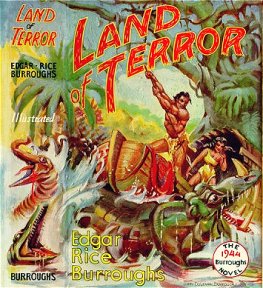

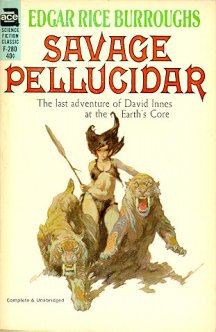
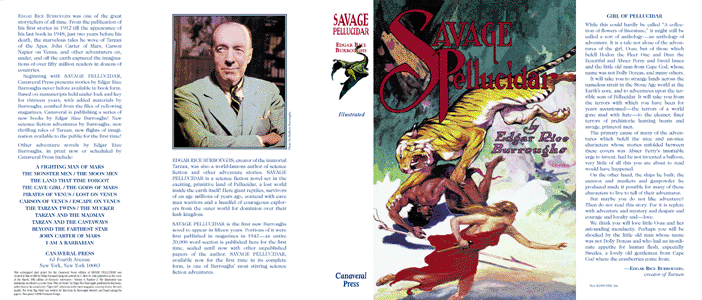
For more Pellucidar art visit
the Lord Greystoke Gallery series
ERBzine
0282 ~ ERBzine
0323 ~ ERBzine
0326 ~ ERBzine
0326a


